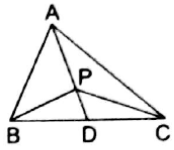In the adjoining figure, AD is one of the medians of a ∆ABC and P is a point on AD.
Prove that
(i) ar(∆BDP) = ar(∆CDP)
(ii) ar(∆ABP) = ar(∆ACP)

Given : A ∆ABC in which AD is the median and P is a point on AD
To prove: (i) ar(∆BDP) = ar(∆CDP),
(ii) ar(∆ABP) = ar(∆ACP).
(i)
In ∆BPC, PD is the median. Since median of a triangle divides the triangles into two equal areas
So, area(∆BDP) = area(∆CDP)----1
Hence proved
(ii)
In ∆ABC AD is the median
So, area(∆ABD) = area(∆ADC) ----2 and
area(∆BDP) = area(∆CDP) [from 1]
Now subtracting area(∆BDP) from ---2 , we have
area(∆ABD) - area(∆BDP) = area(∆ADC) - area(∆BDP)
area(∆ABD) - area(∆BDP) = area(∆ADC) - area(∆CDP) [since area(∆BDP) = area(∆CDP) from –1]
![]() area(∆ABP) = area(∆ACP)
area(∆ABP) = area(∆ACP)
Hence proved.
15